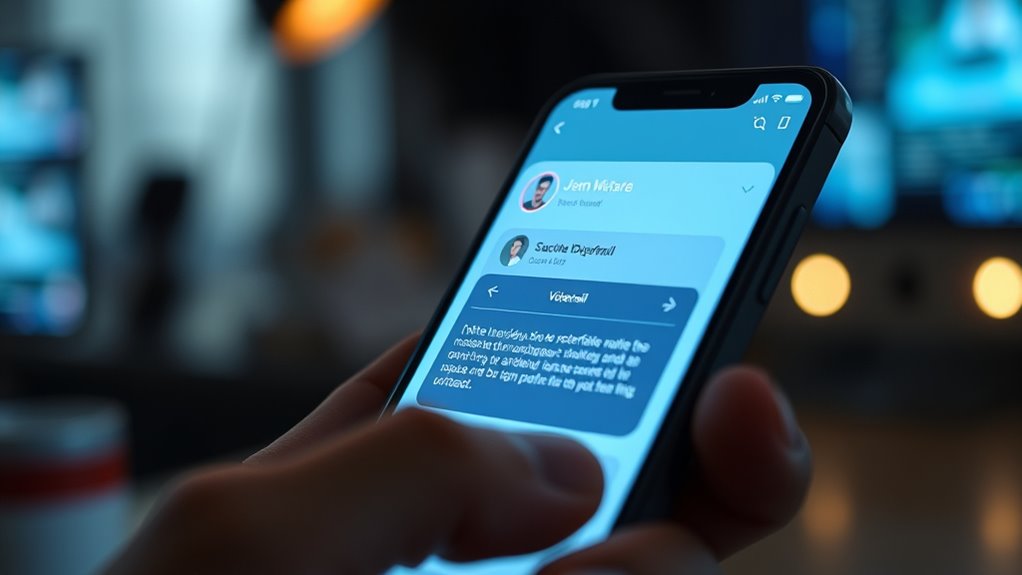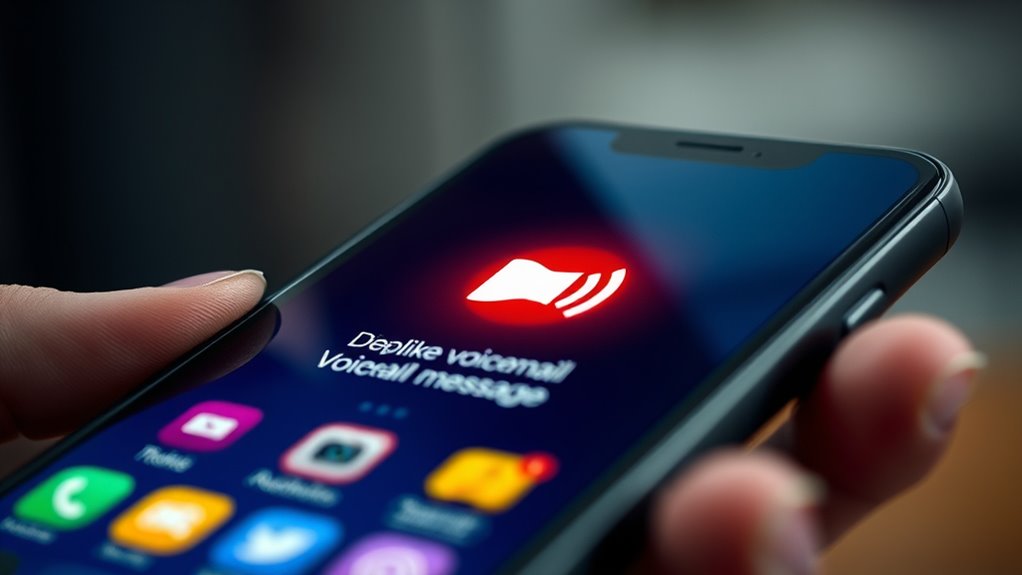Deepfake voicemails now make phishing more dangerous, as AI can mimic trusted contacts convincingly. Scammers use these realistic voices to create urgency, tricking you into sharing sensitive info or taking immediate action. Traditional detection methods no longer suffice, but voice authentication and verification through secure channels can help protect you. Staying aware of these evolving tactics boosts your defenses—continue exploring to discover how to stay one step ahead of these sophisticated scams.
Key Takeaways
- Deepfake voice technology enables scammers to create highly convincing voicemails impersonating trusted contacts.
- Traditional scam detection methods are ineffective against sophisticated deepfake audio impersonations.
- Voice authentication systems help verify caller identities but must be combined with other security measures.
- Urgent or pressure tactics in voicemails are common red flags of deepfake scams.
- Staying informed about deepfake advancements and using multi-layered verification protect against phishing 2.0 attacks.

As cybercriminals evolve their tactics, phishing has become more sophisticated and harder to detect. Today, scammers are leveraging deepfake technology to craft convincing voicemails that can fool even the most cautious individuals. These fake voice messages often sound so authentic that you might not realize they’re scams until it’s too late. This rise in deepfake voicemails underscores the significance of understanding how voice authentication can be your first line of defense. Traditional scam detection methods, such as recognizing suspicious links or email anomalies, aren’t enough anymore. Cybercriminals now use AI to generate realistic voices mimicking trusted contacts, making it increasingly difficult to distinguish a genuine message from a fabricated one.
Deepfake voice scams are growing; verify identities beyond just listening.
You might receive a voicemail that sounds exactly like your boss or a close colleague, urgently requesting sensitive information or immediate action. The voice’s tone, inflection, and background noise can all be convincingly replicated by sophisticated deepfake algorithms. As a result, trusting your instincts alone isn’t enough; you need robust methods to verify the authenticity of these messages. Voice authentication systems are emerging as vital tools in scam detection, analyzing vocal patterns and biometric features that are difficult for AI to replicate perfectly. These systems compare your voice to a previously recorded, verified sample, making it easier to identify imposters even when the voice sounds genuine. However, it’s important to remember that no system is infallible, especially as deepfake technology continues to improve. Increasingly, cybersecurity experts emphasize the importance of cybersecurity vulnerabilities in understanding how these scams can succeed.
You should also stay alert to signs that a voicemail might be a scam. For example, if the message creates a sense of urgency or pressure you into sharing confidential details, it’s a red flag. Never provide sensitive information over the phone unless you’ve independently verified the caller’s identity using multiple methods. Incorporate additional scam detection strategies, such as calling back through official channels or using secure messaging platforms. By combining voice authentication with vigilant scam detection practices, you can better protect yourself from falling victim to these advanced phishing techniques.
Ultimately, the key is to stay informed about how deepfake technology can be exploited in scams. As cybercriminals refine their methods, your best defense is a combination of technological tools and cautious skepticism. Don’t rely solely on intuition—use voice authentication where possible, and always verify before acting on any urgent request received via voicemail. Recognizing the evolving nature of phishing attacks allows you to adapt your defenses and keep your personal and professional information safe from these increasingly convincing scams.
Frequently Asked Questions
How Can I Verify if a Voicemail Is Genuine?
To verify if a voicemail is genuine, you should use voice authentication and caller verification methods. Listen carefully for inconsistencies or unnatural speech patterns that might signal a deepfake. Contact the caller directly through a known number or official channel to confirm their identity. Avoid sharing personal info over unverified messages. These steps help guarantee the voicemail’s authenticity and protect you from potential scams.
Are There Legal Risks in Reporting Deepfake Scams?
Did you know that over 60% of scam victims hesitate to report deepfake scams? When you report these scams, you should be aware of potential legal implications, but failing to report can also lead to legal issues if you overlook fraud. Follow proper reporting procedures to protect yourself and ensure authorities can act. Usually, reporting to law enforcement or consumer protection agencies is safe and essential, minimizing legal risks.
What Technologies Are Used to Create Realistic Deepfake Voicemails?
You’re curious about how realistic deepfake voicemails are made. These involve advanced voice synthesis technology, which uses neural networks to generate human-like speech. By analyzing vast amounts of data, neural networks learn speech patterns and intonations. This allows scammers to produce convincing voice messages that sound authentic. The combination of voice synthesis and neural networks makes deepfake voicemails difficult to detect, posing serious security threats.
Can AI Detect or Block Deepfake Voicemail Attacks?
You might wonder if AI can detect or block deepfake voicemail attacks. While voice authentication helps verify genuine callers, AI detection techniques analyze speech patterns, tone, and inconsistencies to identify fakes. Combining these methods enhances security, but deepfake technology continually evolves, making detection challenging. Staying updated on AI detection advancements and implementing multi-layered voice verification gives you the best chance to prevent these sophisticated scams.
How Vulnerable Are Small Businesses to Phishing 2.0 Attacks?
You’re facing an almost unstoppable wave of phishing 2.0 attacks, which can devastate small businesses if you’re not prepared. Your vulnerability skyrockets without proper employee training and solid cybersecurity policies. These advanced deepfake voicemails can fool even the keenest ears, making it essential to stay vigilant. Regular training and strict security protocols are your best defenses to protect your business from falling prey to these sophisticated scams.
Conclusion
As you step into a world where deepfake voicemails blur the lines between reality and deception, remember that you’re steering a digital minefield. These scams are like wolves in sheep’s clothing, ready to exploit your trust. Stay alert, question strange messages, and verify identities. Only by sharpening your awareness can you avoid falling into these cleverly disguised traps. The landscape is changing fast—be the vigilant guardian of your own security in this evolving cyber wilderness.








